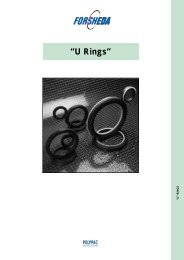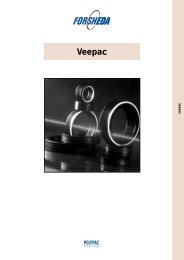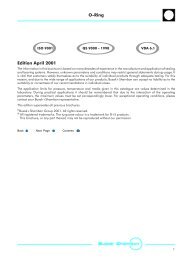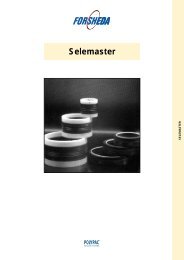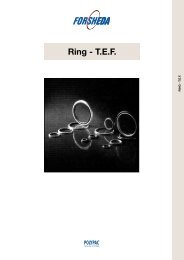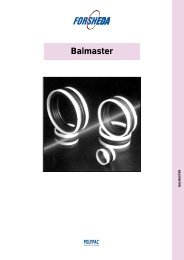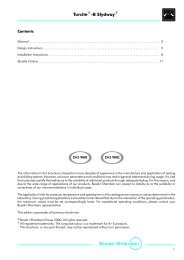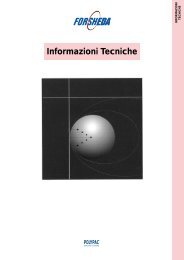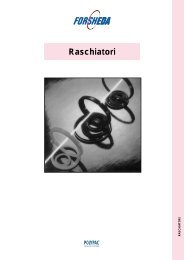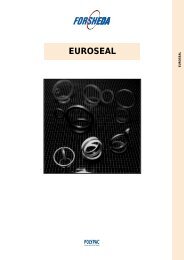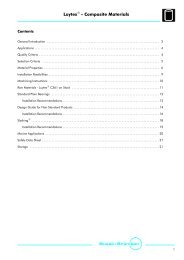Rotary Seals - Dilanda.it
Rotary Seals - Dilanda.it
Rotary Seals - Dilanda.it
Create successful ePaper yourself
Turn your PDF publications into a flip-book with our unique Google optimized e-Paper software.
Radial Oil Seal<br />
Description of rubber materials<br />
N<strong>it</strong>rile Rubber (NBR)<br />
Advantages:<br />
- Good oil resistance<br />
- Good heat resistance up to 100°C in oil<br />
- High tensile strength (special compounds over 20 MPa)<br />
- High elongation at break<br />
- Low swelling in water<br />
Lim<strong>it</strong>ations:<br />
- Poor weather and ozone resistance<br />
- Poor resistance against polar fluids (ester, ether, ketones<br />
and aniline)<br />
- Poor resistance against chlorinated hydrocarbons (carbon<br />
tetrachloride, trichlorethylene)<br />
- Poor resistance against aromatic fluids (e.g. benzene,<br />
toluene)<br />
Fluids, mineral oils and above all high-alloyed mineral oils<br />
(hypoid oils) containing larger quant<strong>it</strong>ies of aromatic<br />
hydrocarbons are cr<strong>it</strong>ical as they have a high swelling<br />
effect on NBR- compounds. The swelling behaviour can be<br />
improved by increasing the acrylon<strong>it</strong>rile content.<br />
However an inferior cold flexibil<strong>it</strong>y and resistance to<br />
compression set must be accepted. The add<strong>it</strong>ives in highalloyed<br />
oils can in certain cases cause an add<strong>it</strong>ional<br />
interaction between the elastomer and the add<strong>it</strong>ive, thus<br />
influencing the elastic<strong>it</strong>y.<br />
Hydrogenated N<strong>it</strong>rile Rubber (HNBR)<br />
Advantages:<br />
- Good oil resistance, also in hypoid oils<br />
- Good heat resistance, up to + 150 °C<br />
- Good mechanical properties<br />
- Good weather and ozone resistance<br />
Lim<strong>it</strong>ations:<br />
- Poor resistance against polar fluids (esters, ethers,<br />
ketones and aniline)<br />
- Poor resistance against chlorinated hydrocarbons (carbon<br />
tetrachloride, trichlorethylene)<br />
- Poor resistance against aromatic fluids (bensene, toluene)<br />
Polyacrylic Rubber (ACM)<br />
Advantages:<br />
- Good resistance against oils and fuels (better than N<strong>it</strong>rile<br />
rubber)<br />
- Heat resistance about 50 °C better than for N<strong>it</strong>rile rubber,<br />
150 °C in oil and 125 °C in air<br />
- Good weather and ozone resistance<br />
Lim<strong>it</strong>ations:<br />
- Not usable in contact w<strong>it</strong>h water and water solutions,<br />
even smaller quant<strong>it</strong>ies of water in oil<br />
- Lim<strong>it</strong>ed cold flexibil<strong>it</strong>y to about -20 °C, somewhat poorer<br />
than normal NBR<br />
- Lim<strong>it</strong>ed tensile strength and tear resistance, especially<br />
above 100 °C<br />
- Poor wear resistance (considerably inferior compared to<br />
NBR)<br />
- Poor resistance against polar and aromatic fluids and<br />
chlorinated hydrocarbons<br />
20<br />
Latest information available at www.busakshamban.com<br />
Ed<strong>it</strong>ion April 2006



